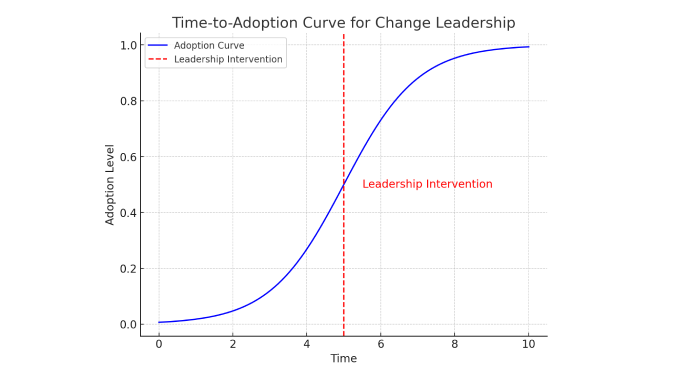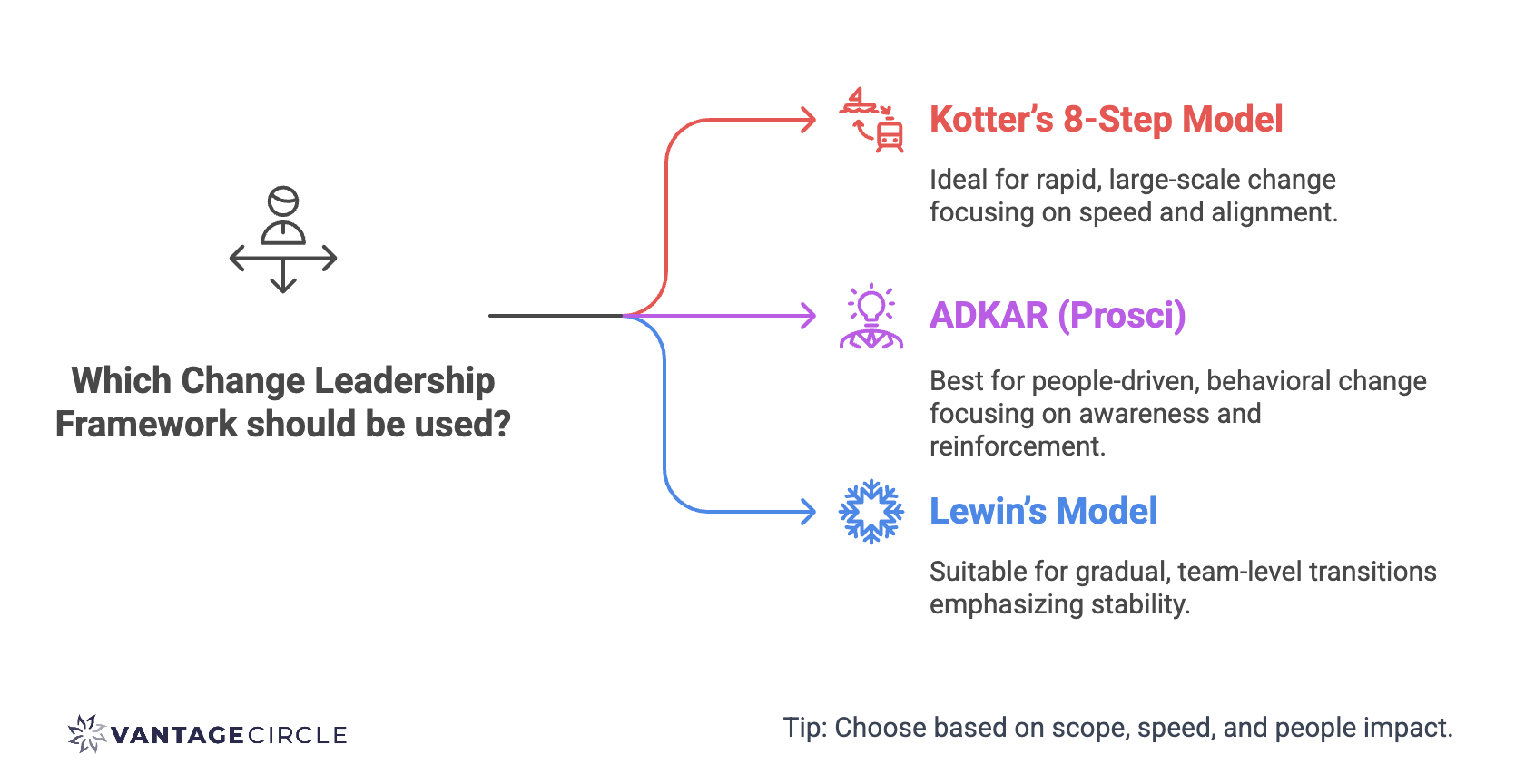Change Leadership: Definition, Principles, and How It Drives Transformation Success

A Global Employee Recognition and Wellness Platform
Change doesn't fail because of resistance; it fails because leaders underestimate the capacity for change within their organizations.
Read that again.
How many times have you heard leaders blame "resistance to change" when a transformation effort collapsed? Well, the truth is that resistance isn't your biggest problem. The real issue? Lack of change leadership. Most leaders don't understand what it actually takes to lead through change.
McKinsey found that nearly 70% of transformations fail, and it's rarely because of a wrong strategy. It's because organizations misunderstand the change process itself. They have brilliant plans, but they're missing the leadership approach that makes transformation stick.
Think about your own organization. How many initiatives launched with fanfare only to quietly fade away six months later?
Why This Matters Now?
Economic pressures, AI disruption, hybrid work, shifting employee expectations; change isn't slowing down. The difference between thriving and surviving? How well you lead through the chaos.
This guide breaks down what change leadership really is, why it matters, and exactly how to do it. You'll learn the three critical roles every change leader must play, six core principles that make transformation sustainable, and proven frameworks you can apply immediately.
Let's start with the fundamentals.
What Is Change Leadership? (And How It's Different from Change Management)
Here's a question most leaders get wrong: Are you leading change, or just managing it?
Change leadership is about influencing and inspiring people through transformation. It's the ability to cast a vision, rally everyone around it, and mobilize the resources needed to make it real. You're not just implementing a plan, you're leading the charge and making sure people actually want to come along.
Change management, on the other hand, is the structured process of moving from point A to point B. It's about logistics, timelines, and systems. Think about project plans, resource allocation, and risk mitigation. It keeps things running smoothly.
Both matter. But here's the difference: management handles the "how," while leadership drives the "why."
Here's a quick comparison to help clarify:
| Aspect | Change Leadership | Change Management |
|---|---|---|
| Horizon | Long-term vision, innovation, and inspiring change | Short-term, process-oriented, and focused on stability |
| Role | Visionary, motivator, and strategic guide | Planner, executor, and coordinator |
| Outcome | Engaged, aligned workforce ready for transformation | Smooth transition with minimal disruption |
Aspect: Horizon
Change Leadership: Long-term vision, innovation, and inspiring change.
Change Management: Short-term, process-oriented, and focused on stability.
Aspect: Role
Change Leadership: Visionary, motivator, and strategic guide.
Change Management: Planner, executor, and coordinator.
Aspect: Outcome
Change Leadership: Engaged, aligned workforce ready for transformation.
Change Management: Smooth transition with minimal disruption.
See the pattern? Leadership energizes people. Management organizes the work. You need both, but leadership is what makes people actually embrace the change rather than just tolerate it.
Think about the last major change in your organization. Did people rally around it with energy and commitment? Or did they grudgingly comply because they had to? That's the leadership gap right there.
Why Change Leadership Matters More Than Ever
Let's be honest, your organization is under pressure from every direction.
AI is rewriting job descriptions faster than HR can update them. Hybrid work has turned "the office" into an abstract concept. Global disruptions keep reminding us that five-year plans are more wishful thinking than strategy. And your employees? They're not just expecting paychecks anymore; they want purpose, flexibility, and growth.
Here's the problem: 73% of organizations can't adjust their leadership approach fast enough to keep up with these changes, according to a LinkedIn study. That's more than half of companies struggling to lead effectively in the exact moment when leadership matters most.
What Makes a Leader Successful in Turbulent Times?
Shridhar Sampath, CEO coach and motivational speaker, puts it simply:
Demonstrated commitment to shared values, and perseverance towards the shared vision while inspiring others to continuously innovate by empowering them and encouraging their hearts – that's what makes a leader successful in this VUCA world.
That's what creates an environment where innovation doesn't have to be forced. It happens naturally because people believe in where they're going.
If you haven't heard of the term VUCA yet, you're living it anyway. VUCA stands for Volatility, Uncertainty, Complexity, and Ambiguity.
When everything feels unpredictable, your team looks at you for direction. They're asking: "Do you know where we're going? Can we trust you to get us there?" This is where effective change leaders make their impact. They align long-term goals, remove barriers, and support their people through the fog of uncertainty.
Here's what most leaders don't realize: how you lead directly impacts how fast change gets adopted.
Without strong leadership, adoption follows a slow, painful S-curve as shown in the image below. Disruption drags on. People resist longer. Productivity dips and stays low.

But with the right guidance and vision? You cut that timeline dramatically. You get people on board faster, reduce friction, and reach full adoption while your competitors are still explaining the change.
You can't afford to wait for things to "fall into place" on their own. The leaders winning right now are the ones who invested in change leadership yesterday. The good news? It's not too late to start today.

The Three Roles of a Change Leader
Change leaders don't just wear one hat; they switch between three distinct roles depending on what the moment demands. Their job is to make transformation human, actionable, and sustainable. Sometimes that means shaking things up. Other times, it means bringing people together.
Here are the three distinct roles every effective change leader needs to master:
1. The Agitator
An agitator challenges the status quo. They question existing assumptions and push teams to see beyond what's comfortable. This role is about shaking things up respectfully, but firmly.
Example: When Satya Nadella took over Microsoft, he disrupted the company's "know-it-all" culture by introducing a "learn-it-all" mindset. The shift changed behaviors and revived innovation across teams.
Pitfall to avoid: Being critical without offering direction. Change should feel constructive, not confrontational. If you agitate without a vision, you just create chaos.
Ask yourself: When was the last time you challenged something everyone else accepted as "just how things are"?
2. The Innovator
Innovators bring imagination and fresh thinking into the change process. They connect ideas, tools, and people in new ways to accelerate transformation.
Example: Think of Airbnb's leadership during the pandemic. Instead of shutting down, they pivoted by offering online experiences, preserving engagement and revenue.
Pitfall to avoid: Innovation that's disconnected from reality. If your ideas aren't tied to actual capacity or strategy, you'll create confusion instead of momentum.
Ask yourself: What's one resource or capability you already have that could be used in a completely different way?
3. The Orchestrator
The orchestrator brings everything together. They align teams, processes, and culture so that transformation doesn't collapse under its own weight. This role is about synchronization; making sure everyone moves in harmony toward the goal.
Example: When Unilever launched its global sustainability agenda, leaders acted as orchestrators. They coordinated actions across hundreds of brands while maintaining a shared purpose.
Pitfall to avoid: Micromanaging. Orchestration isn't about controlling every detail. It's about creating clarity and trust so teams can execute confidently.
Ask yourself: Are your teams aligned on the "why" and the "what next," or are they waiting for you to tell them every step?
Most leaders have a natural default. Maybe you're great at challenging the status quo but struggle with alignment. Or perhaps you excel at bringing people together but hesitate to disrupt.
The best change leaders know how to shift between all three roles as the situation evolves. Early in transformation, you might need to agitate. Midway, you innovate. As things stabilize, you orchestrate.
So, here's a quick reflection for you - Which role do you naturally lead with?
Recommended Read: Key Leadership Behaviors That Matter
Core Principles of Effective Change Leadership
Change leadership is less about control and more about influence. It's about helping people move from uncertainty to confidence. These six principles guide leaders who want transformation to last.
1. Vision: Give People a Reason to Care
A strong vision answers the two questions every employee is silently asking: "Why are we doing this?" and "What's in it for us?"
Without a clear vision, change feels arbitrary. People comply because they have to, not because they believe. But when you connect daily tasks to a bigger purpose, everything shifts. Confusion turns into clarity. Resistance softens into curiosity.
Micro-behavior to adopt: Start every change initiative with a short "north star" statement. Make it simple - one or two sentences that tie business goals to employee impact. Then repeat it. In meetings, in emails, in casual conversations. Repeat it until it becomes second nature.
Don't:
- Launch a change without explaining the "why"
- Change the destination every week
- Hide the hard truths or trade-offs involved
2. Empathy: Understand How Change Feels
Change doesn't just affect systems. It also affects people's routines, their confidence, and their sense of stability. Empathy helps you understand how transitions feel at every level of the organization.
When people feel heard, resistance drops. Trust builds. They stop seeing change as something being done to them and start seeing it as something they're part of.
Micro-behavior to adopt: Spend time with teams outside your leadership meetings. Ask what's making the change hard for them. Then use that feedback to adjust your plans. Don't just collect input and ignore it.
Don't:
- Assume silence means agreement
- Dismiss "soft" concerns as irrelevant noise
- Ask for feedback you never intend to act on
3. Agility: Adapt Without Losing Focus
Plans rarely survive first contact with reality. Agility is what lets you pivot fast without losing momentum or direction.
This isn't about changing course every week. It's about staying alert to what's working and what's not, then adjusting before minor problems become major failures.
Micro-behavior to adopt: Hold short biweekly "change pulse" check-ins. Review progress, identify blockers, and adjust timelines before issues escalate. Keep them tight - 30 minutes max.
Don't:
- Lock timelines when every signal says you need to adjust
- Pivot so often that people lose track of the goal
- Launch massive changes when small, incremental wins would work better
4. Communication: Replace Rumors with Facts
Even a brilliant strategy fails when people don't understand it. Change leaders communicate clearly, frequently, and consistently. They make information accessible and encourage two-way dialogue.
Silence creates rumors. Rumors create resistance. Communication kills both.
Micro-behavior to adopt: Replace long email updates with concise, visual summaries. Explain what's happening, why it matters, and what's next. Make it scannable. And always keep the door open for questions and feedback.
Don't:
- Bury critical decisions in long email threads
- Use jargon or tool names without explaining them
- Announce something once and assume everyone got it
5. Credibility: Do What You Say You'll Do
People don't follow plans; they follow leaders they trust. Credibility is built when your actions match your promises. During change, credibility becomes the foundation for everything else.
One broken promise can undo months of relationship-building. But one visible win? That builds belief fast.
Micro-behavior to adopt: Deliver one visible win early in the transformation. Something people can see and feel. It proves that change is actually working.
Don't:
- Overpromise on scope or timelines
- Hide mistakes or shift blame when things go wrong
- Delegate all the hard, uncomfortable parts to others
6. Empowerment: Give People Ownership
Real change happens when people feel ownership, not obligation. Empowered employees become ambassadors for transformation. They bring energy, ideas, and accountability that no top-down directive can replicate.
When you empower people, you multiply your impact.
Micro-behavior to adopt: Identify "change champions" in each department. Give them real autonomy to adapt the change message for their teams and keep their peers engaged. Don't just make them messengers, make them leaders.
Don't:
- Centralize every single decision at the top
- Turn champions into glorified messengers with no real authority
- Ignore local context and constraints that affect how change lands
Recommended Read: Navigating Leadership Accountability in Recognition Practices
Frameworks in Practice
Leading change isn't just about intent; it's about having a structure to follow. Frameworks give you a roadmap when everything feels chaotic. But here's the catch: the wrong framework at the wrong time can do more harm than good.
Let's look at three proven frameworks and when to use each one.
Kotter's 8-Step Model: When You Need Momentum Fast
Developed by Harvard professor John Kotter, this model is built for large-scale transformation where speed and alignment matter most. It's about creating a movement, not just managing a project.
The eight steps:
- Create urgency – Show why change must happen now, not later
- Build a guiding coalition – Assemble a powerful group of change champions
- Form a strategic vision – Define what success actually looks like
- Communicate the vision – Repeat it everywhere until it sticks
- Empower action – Remove obstacles slowing people down
- Generate quick wins – Celebrate visible progress early
- Sustain acceleration – Build on wins to drive further change
- Anchor change in culture – Make new behaviors the norm
When to use it: When your organization needs to ignite momentum quickly. When employees need inspiration more than instruction. When you're dealing with an enterprise-wide transformation that requires emotional buy-in.
ADKAR Model: When Individual Adoption Matters Most
The ADKAR model, created by Prosci founder Jeff Hiatt, zooms in on the individual side of change. It's perfect when transformation success depends on how well each person adapts, not just how fast the organization moves.
The five building blocks:
- Awareness: Help people understand why change is happening
- Desire: Build motivation by showing personal relevance
- Knowledge: Train and educate people on what to do differently
- Ability: Give them the tools, support, and confidence to perform
- Reinforcement: Recognize and reward behaviors that sustain change
When to use it: Process rollouts. Digital upskilling initiatives. Culture shifts. Anywhere people need clarity and confidence, not pressure. ADKAR prevents "initiative fatigue" by meeting employees where they are emotionally and practically.
Lewin's Change Model: When Stability Matters
Kurt Lewin's model is one of the earliest and simplest frameworks. It breaks change into three human-centered phases that prioritize psychological safety and gradual adaptation.
The three phases:
- Unfreeze: Challenge existing beliefs. Show why the current way no longer works. Prepare people mentally for what's coming.
- Change: Introduce new processes, behaviors, or structures. Encourage experimentation and learning. Give people space to adapt.
- Refreeze: Reinforce new norms through consistency, rewards, and storytelling. Let the new way become "just how we do things."
When to use it: Gradual, team-level transformations. Organizations that value structure and stability. When you need to build trust before asking people to act.
Choosing the Right Framework

The right framework isn't about preference; it's about fit. Kotter builds movement. ADKAR builds belief. Lewin builds stability.
The best leaders? They combine elements from all three, knowing when to accelerate and when to pause. They don't follow frameworks rigidly—they adapt them to what their teams actually need.
How to Measure If Your Change Leadership Is Actually Working
If you're not measuring your change efforts, you're just guessing.
Without measurement, you end up managing perception instead of progress. You think things are going well because no one's complaining loudly. But silence isn't the same as success.
The goal is simple: track what's changing, how people are responding, and whether it's creating lasting impact. Change leadership success can't rely on dashboards alone. It must reflect what is happening on the ground.
Here are the four metrics that matter most:
1. Adoption: Are People Actually Using the Change?
Adoption shows how many people have embraced the new system, process, or behavior. High adoption means the change is becoming part of daily work, not just something people know about.
Leading indicator: Number of users or teams actively engaging with the new process
Lagging indicator: Drop in reliance on old systems or workarounds
2. Proficiency: Are People Doing It Right?
Adoption isn't enough if people are doing things incorrectly. Proficiency measures how confidently and accurately teams perform after the change. Are they just going through the motions, or have they truly learned the new way?
Leading indicator: Completion rates in training or enablement programs
Lagging indicator: Quality and speed of task execution
3. Utilization: Is the Change Being Used Deeply?
Utilization measures the depth of engagement. It tells you whether the change is driving meaningful activity or just superficial interest. Are people using 10% of a new tool's features, or are they really leveraging it?
Leading indicator: Feature or process usage frequency
Lagging indicator: Sustained participation after 60–90 days
4. Sentiment: How Do People Actually Feel About It?
Numbers don't tell the full story. Sentiment measures how employees feel about the change. It measures their confidence, trust, and willingness to keep improving. This is where you catch silent resistance before it becomes active sabotage.
Leading indicator: Pulse survey scores or open-text feedback
Lagging indicator: Retention rates, absenteeism, and team morale over time
Red Flags vs. Green Flags: Quick Reference Checklist while Measuring Change Leadership
Here's how to spot whether your change is on track or headed for trouble:
| Metric | Red Flag (Warning Signs) | Green Flag (Healthy Signs) |
|---|---|---|
| Adoption | Employees still use old systems or methods | Teams have fully shifted to the new way of working |
| Proficiency | Errors or confusion remain high even after rollout | Employees perform tasks confidently and accurately |
| Utilization | Usage drops soon after launch | Engagement stays steady and grows over time |
| Sentiment | Feedback shows frustration or fatigue | Surveys reflect optimism and trust in the process |
Aspect: Adoption
Red Flag (Warning Signs): Employees still use old systems or methods
Green Flag (Healthy Signs): Teams have fully shifted to the new way of working
Aspect: Proficiency
Red Flag (Warning Signs): Errors or confusion remain high even after rollout
Green Flag (Healthy Signs): Employees perform tasks confidently and accurately
Aspect: Utilization
Red Flag (Warning Signs): Usage drops soon after launch
Green Flag (Healthy Signs): Engagement stays steady and grows over time
Aspect: Sentiment
Red Flag (Warning Signs): Feedback shows frustration or fatigue
Green Flag (Healthy Signs): Surveys reflect optimism and trust in the process
You don't need to track all of these every single day. But you do need to establish baseline measurements early and check them regularly.
Final Thoughts: Change Leadership Is a Mindset
Change leadership isn't a single framework you implement once and forget. It's not a certification you earn or a workshop you attend. It's a mindset, a way of showing up for your team when everything feels uncertain.
The most successful leaders do three things consistently:
- They combine clarity of vision with genuine empathy
- They stay agile enough to pivot without losing direction
- They measure what matters and adjust based on real feedback, not assumptions
Tools and models help. Frameworks provide structure. But at the end of the day, it's your leadership that turns plans into progress. It's your ability to inspire belief, remove barriers, and sustain momentum that makes transformation stick.
FAQs
1. What is the definition of change leadership?
Change leadership is the ability to guide and influence people through transformation by combining vision, communication, and empathy. It focuses on leading people through change, not just managing the process.
2. What are examples of change leadership?
Examples include a CEO introducing an agile culture across the organization, a manager leading a digital transformation rollout, or an HR head reshaping workplace policies to support hybrid work—all while engaging and supporting teams through the transition.
3. Why do we need change leadership?
Without effective leadership, change efforts often stall. Change leadership ensures that people understand the purpose behind transformation, stay motivated, and align their efforts toward a common goal. It turns uncertainty into progress.















